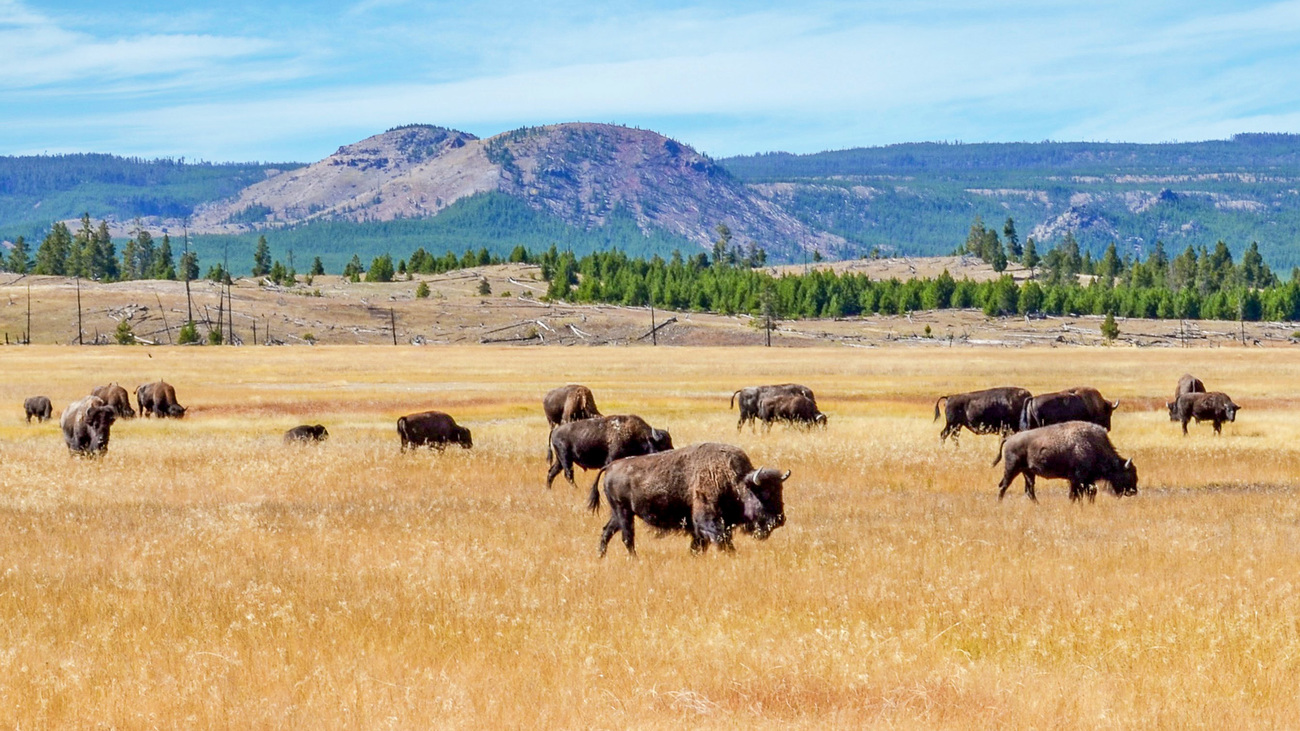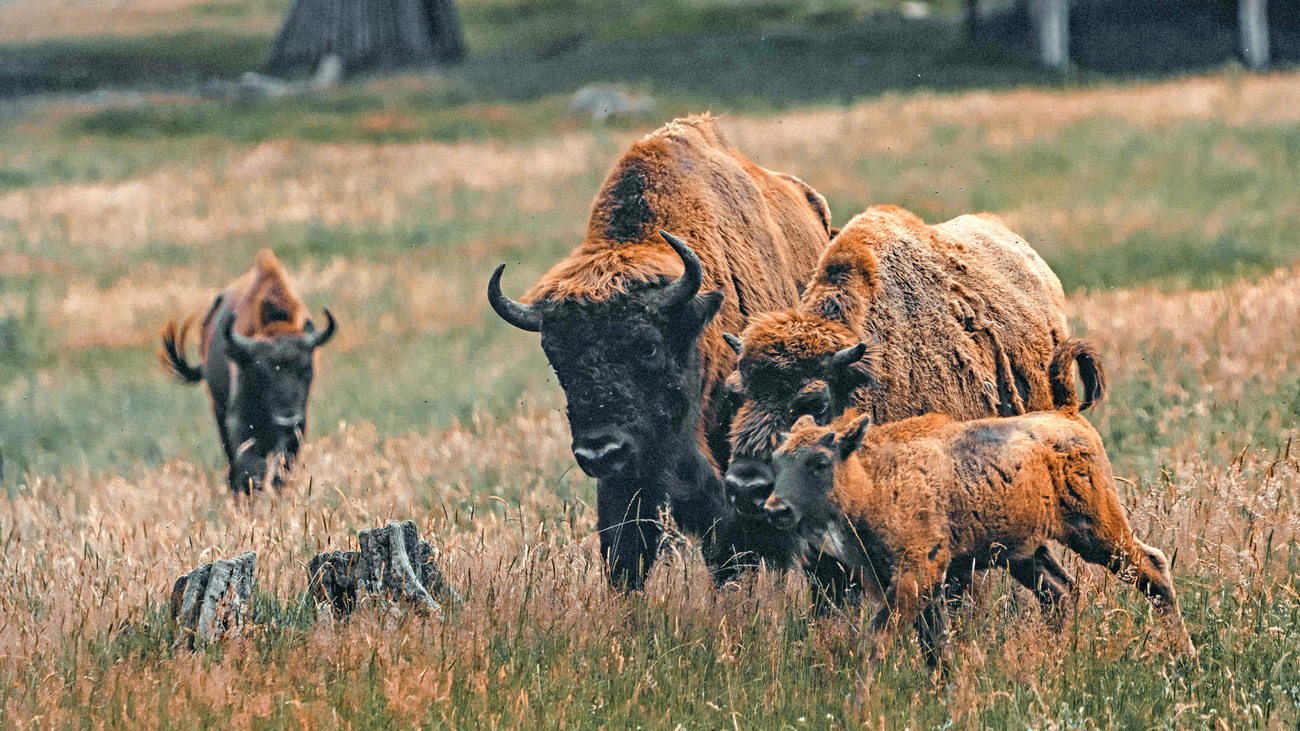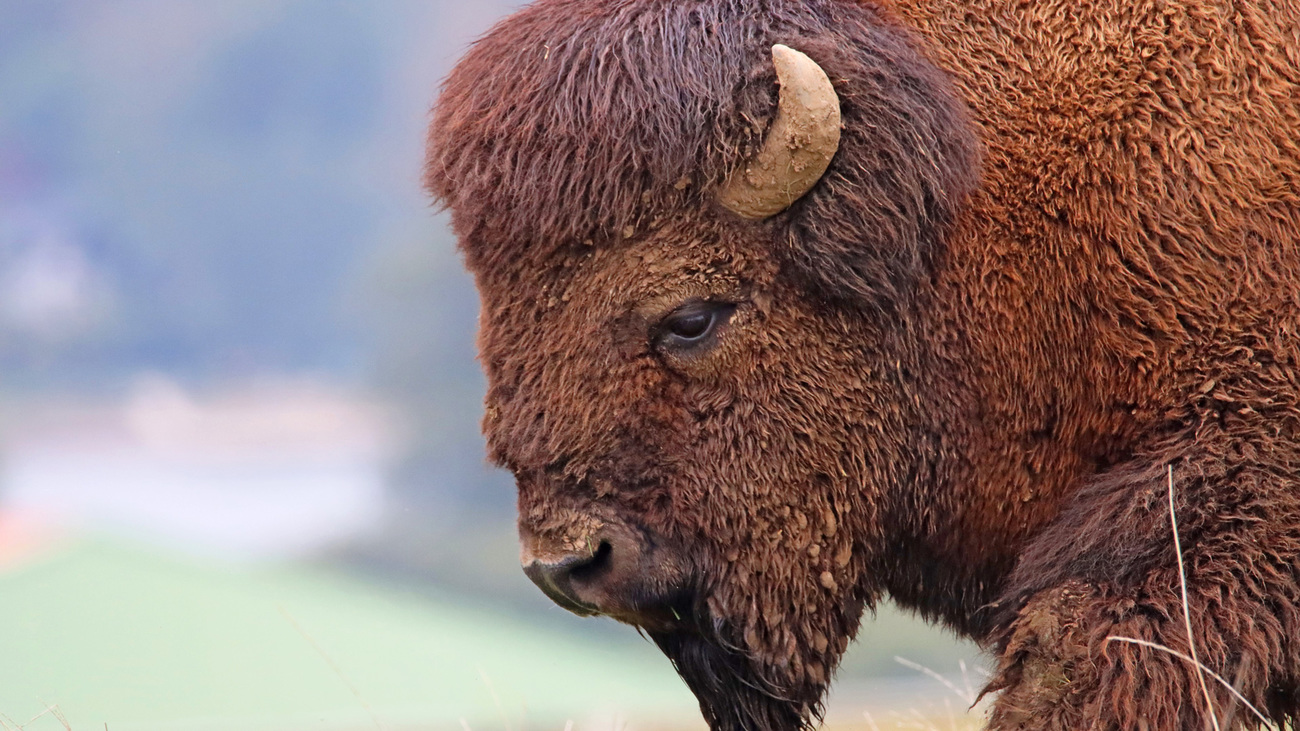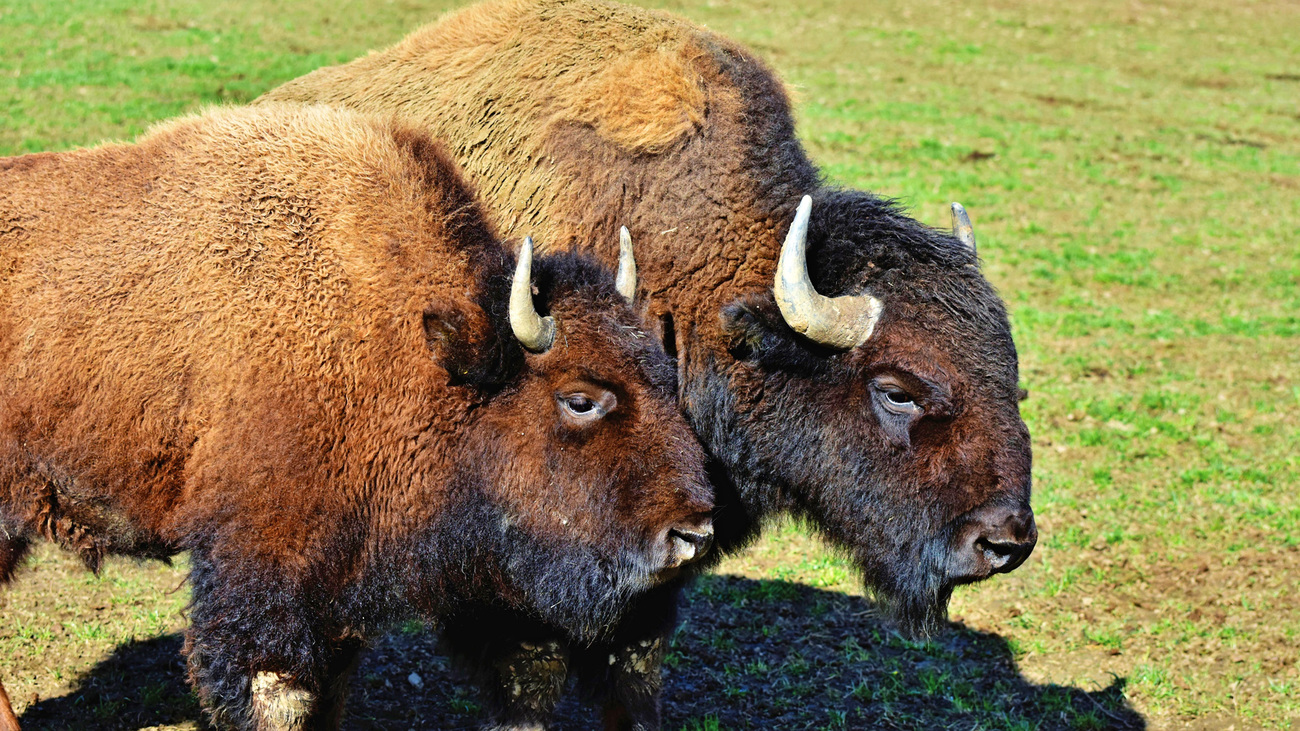Bison
What is a bison?
Bison are native to both North America and Europe. American bison, often called American buffalo—though they are not true buffalo—are symbolic of the North American plains. These large animals once covered the Great Plains and played an important role within Indigenous communities. Sadly, during the 18th and 19th centuries, vast numbers of bison were slaughtered for food, sport, and as an attack on Indigenous communities, to the point of near extinction. Thankfully, their population has recovered, with up to 400,000 bison now known to exist in the world.
As the largest and heaviest land mammals in North America, bison are known for their massive size. The American bison’s head is so heavy that it can’t be raised to shoulder level. They also have pronounced humps at their shoulders and large, powerful bodies. American bison are covered in shaggy, dark brown fur that grows longer around their head and neck, forming a ‘beard’. Both male buffalo (bulls) and female buffalo (cows) have short, upcurved horns on the tops of their heads, though cows’ horns are smaller. Adult bulls are larger than cows, with males reaching up to two metres (6.5 feet) tall compared to 1.5 metres (5 feet) for females. Male bison are also substantially heavier than females, weighing 900 kilograms (1980 pounds) compared to 320 kilograms (700 pounds).
European bison, also known as wisent, differ from American bison in various ways. They tend to be larger than American bison, with longer legs, though their bodies are less stout. European bison typically live in the woodlands, and although some American bison do occupy woodlands, they are more commonly found in the grasslands and plains.
Despite their vast size, bison are agile and fast, reaching speeds of up to 65 kilometres per hour (35 miles per hour). They are also strong swimmers and can jump over fences. Bison tend to run or stampede away from threats and predators. Historically, their two main predators have been wolves and human hunters.
Bison are herbivores, with diets consisting mainly of grasses, herbs, twigs, and leaves. Their strong, muscular tongues help them tear and consume vegetation. When they eat, bison regurgitate their food and chew it a second time before finally digesting it. In the winter, their shoulder hump comes in handy. It allows them to swing their head from side to side to help clear snow and access the grasses below.
Groups of bison are called herds. They tend to live in smaller herds with one or more females and their offspring. Adult males tend to live on the periphery of these groups, sometimes forming their own small herds. Every now and then, herds will join together to form much larger groups, which can number in the hundreds.
During mating season, bulls will attempt to assert their dominance through head-butting. After breeding, cows have a nine-month gestation period, after which they will usually give birth to a single baby bison, called a calf. Both bulls and cows are protective over their calves.
Bison are of great ecological importance to their habitats. Their grazing patterns promote plant diversity and help prevent the dominance of certain plant species, maintaining a healthier balance within the ecosystem. Their role in shaping and maintaining healthy grasslands can aid in carbon sequestration, as diverse grasslands store carbon more effectively than degraded ones.
What is a bison’s scientific name?
The scientific name for American bison is Bison bison. The scientific name of the European bison is Bison bonasus.
There are two subspecies of American bison: the wood bison (Bison bison athabascae) and the plains bison (Bison bison bison).
Bison are members of the Bovidae family, which also includes antelopes, sheep, goats, cattle, buffalo, and bison.
Sometimes, American bison are mistakenly called buffalo. It’s believed that the term buffalo derives from the French word for beef, ‘boeuf’. Bison are not true buffalo like the African buffalo, water buffalo, and anoa.
Are bison endangered?
According to the IUCN Red List, American bison are near threatened. Their status is largely due to their dependence on conservation efforts.
In terms of the IUCN Species Recovery Category—or the Green Status assessment—American bison are considered critically depleted with a species recovery score of 17%. They are classed as critically depleted mainly because the American bison population is no longer found in many of its original habitats. The future of American bison populations looks hopeful, though, as they are rated with a medium recovery potential.
European bison are also classified as near threatened, though their populations are increasing. Their growing numbers are thanks to strong conservation efforts, which saw the reintroduction of European bison to the wild after they went extinct in the wild following World War I. Between 1988 and 1996, they were classified as vulnerable. From 1996 until 2008, they were considered endangered. Since 2000, their populations have increased. The European bison was classified as vulnerable in 2008 and near threatened as of 2020.
Where do bison live?
Bison are highly adaptable animals, able to live in diverse climates from the deep snow to the driest, most arid locations. Historically, American bison were widespread across the vast grasslands of North America, from Canada’s plains to Mexico’s deserts. While they’re still found across North America, their range is now less than 1.2% of what it once was. Yellowstone National Park is the only place in the United States where bison have lived uninterrupted since prehistoric times.
European bison originally inhabited forests and woodlands across Europe, from France to the Volga River and the Caucasus Mountains. They were reintroduced to several regions after they went extinct in the wild. They can now be found in countries including Belarus, Bulgaria, Germany, Latvia, Lithuania, Poland, Romania, Russia, Slovakia, and Ukraine.
Threats
American and European bison face several threats to their survival, including hunting, habitat loss, climate change, and inconsistent conservation policies.

Hunting
Hunting has historically had a severe impact on both American and European bison populations. In the 1800s, the American bison was nearly eliminated due to hunting practices. Bison were targeted for food, sport, as well as for political reasons. Because Indigenous Peoples relied so heavily on American bison, European settlers over-hunted them to intentionally reduce populations. Prehistorically, there were millions of bison across America, but by the end of the 1800s, only a few hundred individuals remained.
Despite their low population numbers, European bison are still subject to culling for commercial purposes and, surprisingly, to control populations.
Habitat loss
The American bison has lost a substantial portion of its range to habitat loss. Urbanisation, agriculture, and industrial development have encroached on its natural habitat, leading to fragmentation and loss of suitable grazing areas. In particular, converting grasslands into agricultural land has reduced the available space for bison herds and disrupted their migratory patterns.
Climate change
As climate change disrupts weather patterns, the world is seeing more extreme weather events, including storms, flooding and extreme temperatures. This puts bison in danger, especially where it affects their natural habitat.
Rising temperatures are also causing bison to shrink in size. As the grasslands get warmer, grasses are storing less protein, leading bison to consume less nutritionally dense plants.
Inconsistent policy
For European bison, inconsistent conservation policies threaten their survival. Without clear policies protecting the species, the reintroduced population is at risk of further decline.
In the majority of the regions that European bison inhabit, they are a protected species. However, enforcement of the relevant policies is inconsistent between these countries, which not only slows their population growth but may end up preventing it.
FAQs
Are bison and buffalo the same?
American bison are sometimes called American buffalo. However, though they are members of the same family, bison are not true buffalo. True buffaloes include the water buffalo and African buffalo, which are found in South Asia and Africa, respectively.
There are a few ways that you can distinguish between bison and buffalo:
- Region: Bison are found in North America and Europe, while buffalo live in Asia and Africa.
- Horn size: Bison have smaller, upcurved horns, while buffalo have much larger and broader horns that can span up to 1.8 metres (6 feet).
- Hump: Bison are characterised by a large hump on their shoulders, which buffalo do not have.

Are bison extinct?
Thankfully, bison are not currently extinct. The American bison almost reached the point of extinction in the late 19th century due to overhunting.
The European bison did go extinct in the wild in the early 20th century. However, thanks to conservation efforts and the reintroduction of the species to the wild, their populations are now increasing.
How big are bison?
American bison are North America’s largest and heaviest mammal, although they are shorter than moose.
The male American bison, called a bull, is larger than the female, called a cow, standing at two metres (6.5 feet) tall. Females reach 1.5 metres (5 feet). Males are also more than twice as heavy, weighing 900 kilograms (1,980 pounds) compared to females, which weigh 320 kilograms (700 pounds).
European bison have longer legs, making them taller than American bison, though their bodies are generally smaller. They reach average heights of 1.75 to 2 metres (5.74 to 6.56 feet) and can weigh anywhere from 424 to 920 kilograms (935 to 2030 pounds).
What do bison eat?
Bison are herbivores. Grasses are their primary food source, but they also eat herbs, twigs, leaves, flowers, lichen, and berries. When grasses are covered in snow in the winter, they’ll swing their heads to clear it.
Where do bison live?
American bison are found in the grasslands and plains of North America, as well as some forests. European bison live in Europe’s forests and woodlands.
How many bison used to roam North America?
Before European colonists settled in North America, an estimated 30 to 60 million bison roamed across North America, covering the great plains. Unfortunately, during the 1800s, American bison were slaughtered, bringing their populations down from the millions to just a few hundred.
Why did the European bison go extinct?
In the early 20th century, European bison were driven to the brink of extinction due to a combination of factors, including hunting and habitat loss. Thankfully, there were some European bison in captivity that could be reintroduced to the wild. Since then, the populations of European bison have slowly climbed, with 2,518 mature individuals known to exist in the wild.
How fast are bison?
Bison are surprisingly fast and agile for their size. When they run, they can reach speeds of up to 65 kilometres per hour (35 miles per hour).
Are bison dangerous?
As with any wild animal, bison can be unpredictable, and humans should keep their distance. When frightened, bison can erupt into stampedes, which are dangerous for both the animals and anyone in their way, as the sheer force and speed of the bison can cause injuries or damage.
In Yellowstone National Park, where the largest known wild population of American bison resides, bison have injured more humans than any other animal.
For these reasons, you should never try to approach bison in the wild.

How can you help?
Conservation efforts are necessary to protect both American and European bison, which have both faced near extinction.
